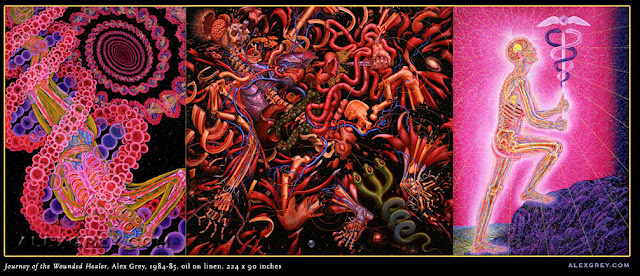
Environmental justice
is also about
our state of mind
BIOPHYSICAL AND MENTAL WELLNESS
INTERRELATED
In 1914, Alice Hamilton published an article in the American Journal of Public Health that focused on the workplace health and safety problems facing workers in what she called the “dangerous trades.” Perhaps better than most of her contemporaries, Hamilton – who was a physician, research scholar, and activist – understood that the environment as a place that surrounded and permeated our existence directly and indirectly affected not just our physical health but our mental wellness as well.
Hamilton made this connection early in her career when she was asked to serve on the Illinois Commission on Occupational Diseases; she was the only woman asked to serve. While the focus on the Commission’s work was the lead industry and the uses of lead in other industries, she was also a compassionate advocate for workers’ rights since she realized that most workers did not report health problems or exposure to contaminants because of a fear of losing their jobs. In other words, Hamilton realized that work-related stress was the result not just of unhealthy working conditions and immense productivity pressures but psychological conditions induced by fear and a sense of powerlessness.
The medical establishment has slowly come to acknowledge the direct connection between our environment and our health – and by health I mean both biophysical and mental wellness. The sources of what is today known as “eco-psychology” lie beyond the struggle to improve the industrial and urban environments. In his influential book Forcing the Spring, Robert Gottlieb introduces the enigmatic figure of Bob Marshall, a white man of great privilege who was a fervent wilderness preservation advocate. Marshall dedicated a good portion of his life to finding ways to improve the condition of the working class through the mental and spiritual renewal he thought possible by means of total immersion in the natural environment.
While I am the first to criticize the concept of wilderness as Eurocentric, I will nonetheless give Marshall credit for realizing that maintaining a connection to nature is healthy. In 1925, Marshall wrote that: “people can not live generation after generation in the city without serious retrogression, physical, moral and mental…” and he advocated that even “the most destitute” should be able to “vacation in the forest” (quoted in Forcing the Spring, p. 16).
In more contemporary times, researchers have found a wide range of quantitative and qualitative evidence to support the basic notion that being close to nature is good for our mental and physical health. For example, a study of Dutch men and women found that people who live within 1 kilometer (.6 miles) of a park or wooded area experience less anxiety and depression. Reports on this study highlight the idea that a wide variety of mental and physical health indicators appear to be strongly associated with access to “green space.”
The Dutch study looked at the medical records of 345,143 people and evaluated these for 24 conditions including cardiovascular, respiratory and neurological diseases. The information was correlated with how much green space was located within 1 kilometer and 3 kilometers of a person’s postal code. The study found that:
People living in more urban environments had a higher prevalence of 15 of the 24 conditions, with the relationship strongest for anxiety disorder and depression…In areas with only 10% of green space, about 2.6% of people experienced anxiety disorders, compared to 1.8% of people in areas with 90% green space. The disparity was evident for depression as well — 3.2% of people living in more urbanized areas had depression versus 2.4% of those in more rural areas…The health benefits were evident only when the green acres were within a kilometer, not at the 3 kilometer perimeter, except for anxiety disorders, gastrointestinal digestive disorders and so-called medically unexplained physical symptoms…

Finally, and most significantly, the study found that “children and poor people suffered disproportionately from lack of green acres.”
The issue of environmental justice is thus more than relevant. The environmental justice discourse often focuses on ecological “wrongs” like disproportionate exposure of people of color or low-income communities to toxins and other environmental risks. We also need to understand that environmental justice is about addressing unequal access to ecological “rights” or “goods” like so-called green amenities including open space, parklands, gardens, woodlands, and forests.
Recent studies in the U.S. have resulted in findings that echo the Dutch research. For example, a University of Illinois-Chicago study found that that experiencing nature and the outdoors benefit our mental and physical health. Dr. Francis (Ming) Kuo – who has worked for years with the Centers for Disease Control (CDC) and served as an adviser to the U.S. Congress – was the lead author of the study, which focused on inner-city youth, young adults, and elderly persons. The results were published in 2010 report entitled, Parks and Other Green Environments: Essential Components of a Healthy Human, which was released by the National Recreation and Park Association.
Professor Kuo summarizes the major findings and implications of the study, which is worth quoting at length:
Through the decades, parks advocates, landscape architects, and popular writers have consistently claimed that nature had healing powers…But until recently, their claims haven’t undergone rigorous scientific assessment…Researchers have studied the effects of nature in many different populations, using many forms of nature…A wealth of new studies has provided firm evidence for going green….Just as rats and other laboratory animals housed in unfit environments undergo systematic breakdowns in healthy, positive patterns of social functioning, so do people…In greener settings, we find that people are more generous and more sociable. We find stronger neighborhood social ties and greater sense of community, more mutual trust and willingness to help others…In less green environments, we find higher rates of aggression, violence, violent crime, and property crime—even after controlling for income and other differences. We also find more evidence of loneliness and more individuals reporting inadequate social support.
The study suggests that access to nature and green space is associated with improved cognitive functioning and improved overall mental health. In contrast, less access to nature is strongly correlated with “exacerbated attention deficit/hyperactivity disorder symptoms, higher rates of anxiety disorders, and higher rates of clinical depression.”
According to a summary of Kuo’s study at Psychcentral, the research findings go beyond social and psychological health outcomes to include physical health outcomes. Exposure or enhanced access to a “greener” environment were found to enhance recovery from surgery, enable and support higher levels of physical activity, improve immune system functioning, help diabetics achieve healthier blood glucose levels, and improve functional health status and independent living skills among older adults. By contrast, environments with less green space are associated with greater rates of childhood obesity; higher rates of 15 out of 24 categories of physician-diagnosed diseases, including cardiovascular diseases; and higher rates of mortality in younger and older adults.
While all this is great news for proponents of a more modern and updated version of Bob Marshall’s visionary ideas, it is also problematic for several reasons, not the least of which is derived from a principal tenet of the environmental justice movement, which is that there are structured inequalities that produced radically variant levels of access among different race/ethnic and social class groups with respect to environmental amenities like open space and parks. This seems all the more important given Dr. Kuo’s final observation about the significance of the study: “While it is true that richer people tend to have both greater access to nature and better physical health outcomes, the comparisons here show that even among people of the same socioeconomic status, those who have greater access to nature have better physical health outcomes.”
The challenge for advocates of equity of health outcomes through environmental justice is to address the degradation of the ecological conditions surrounding working class, poor, and race/ethnic communities while promoting a transformation of access to nature writ-large. Perhaps the single best way to do this is not to just follow Bob Marshall’s lead by getting workers and inner-city youth to go out on wilderness [sic] treks, but rather to bring nature back into the city. Urban agriculture provides one significant path toward the realization of a greener [sic] environment for inner-city dwellers.

Lastly, we would do well to learn invaluable lessons about an urban form that is kinder to bodies and minds from ancient civilizations like the Colhua Mexica (qua Aztecs) whose cities were the epitome of green living, sustainability, and self-reliance. The Mexica understood that the city was a sacred home space, the place where one lived, worked, played, prayed, ate, and learned. Their cities were at once habitat for humans and for wildlife; they recycled all human and agricultural wastes and fiercely protected their watersheds and forests. Above all, they valued the importance of healthy food and a clean physical environment filled with beauty, which is why the Spaniards were so impressed with their rose gardens, home fish ponds, aviaries, protected forests, and endless floating gardens.
The future of environmental justice as a social movement and as a matter of effective law and public policy will draw inspiration from these antecedent civilizations and learn to place higher value on ecology over economy to promote the physical, mental, and spiritual health of the people and all other inhabitants of our little planet.
Photo credits:
